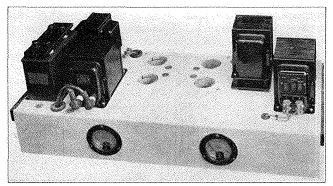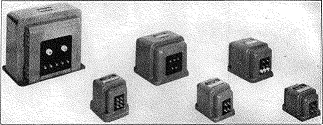| Electronic Transformers and Circuits is a free introductory textbook on transformers and related circuits. See the editorial for more information.... |

|

Home  Transformer Construction, Materials, and Ratings Transformer Construction, Materials, and Ratings  Mountings Mountings |
||||||






|
||||||
Mountings
Both types of cores may be built into neat assemblies with the laminations exposed, and the coils covered by end cases, such as those in the amplifier of Fig. 16.
When complete enclosure is desired, assemblies like those in Fig. 17 are used.
The degree of enclosure depends on many conditions, among them the following:
(b) Temperature Rise. Transformers handling large amounts of power may become hot because of the electrical losses. To seal them in containers imposes additional obstacles to the dissipation of this heat. Fortunately the wire size is large enough to withstand corrosion without developing open circuits. Such units may be of the open type. (c) Space. Sealing a transformer usually requires more space than mounting the core and coil directly on the chassis or panel. End cases like those in Fig. 16 do not require much space but do reduce cooling by convection. When air is used to cool other apparatus, power tubes for instance, it is very often circulated near or through the transformer to prevent the coils from overheating. (d) Voltage. In high-voltage dry-type transformers, enclosure in a metal case may add to the difficulties of insulating the windings. In oil-filled transformers, a tank is required for the oil and enclosure is thereby provided. (e) Appearance. Generally speaking, enclosed transformers are neater than the open type. This fact is given consideration where space is available, especially in broadcast apparatus.
|
||||||
Home  Transformer Construction, Materials, and Ratings Transformer Construction, Materials, and Ratings  Mountings Mountings |
||||||
Last Update: 2011-01-24



